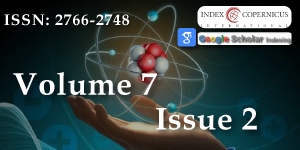Precessional Motion Emerging from Relativistic Component of External Force
Main Article Content
Abstract
The external force in the relativistic equation of motion can be separated into two components: Fr and Fp. The first is expressed by the physical force divided by the square of the relativistic Lorentz factor, i.e γ2. This force dominates for non-relativistic velocities and vanishes for velocities approaching the speed of light c. On the other hand, the second term increases from zero with increasing velocity and dominates for velocities close to c. It is then a purely relativistic component. The characteristic feature of this component is its zero power, Fp . v = 0, but it is responsible for the relativistic precession. The effect was confirmed by numerical solutions of the equation of motion. Relativistic formulas for the precession frequency for point objects moving in selected fields of central forces were also derived analytically. It has been shown that for weak gravitational interactions, the correction for relativistic precession is small, negligibly small for Earth, and relatively small, though measurable, for Mercury. In turn, for the microworld and electrostatic forces (e.g., for the hydrogen atom), relativistic precession can fundamentally affect the movement of the electron.
Article Details
Copyright (c) 2024 Wolny J, et al.

This work is licensed under a Creative Commons Attribution 4.0 International License.
The International Journal of Physics Research and Applications is committed in making it easier for people to share and build upon the work of others while maintaining consistency with the rules of copyright. In order to use the Open Access paradigm to the maximum extent in true terms as free of charge online access along with usage right, we grant usage rights through the use of specific Creative Commons license.
License: Copyright © 2017 - 2025 |  Open Access by International Journal of Physics Research and Applications is licensed under a Creative Commons Attribution 4.0 International License. Based on a work at Heighten Science Publications Inc.
Open Access by International Journal of Physics Research and Applications is licensed under a Creative Commons Attribution 4.0 International License. Based on a work at Heighten Science Publications Inc.
With this license, the authors are allowed that after publishing with the journal, they can share their research by posting a free draft copy of their article to any repository or website.
Compliance 'CC BY' license helps in:
| Permission to read and download | ✓ |
| Permission to display in a repository | ✓ |
| Permission to translate | ✓ |
| Commercial uses of manuscript | ✓ |
'CC' stands for Creative Commons license. 'BY' symbolizes that users have provided attribution to the creator that the published manuscripts can be used or shared. This license allows for redistribution, commercial and non-commercial, as long as it is passed along unchanged and in whole, with credit to the author.
Please take in notification that Creative Commons user licenses are non-revocable. We recommend authors to check if their funding body requires a specific license.
Rindler W. Introduction to Special Relativity. 2nd ed. Clarendon Press; 1991. Available from: https://philpapers.org/rec/RINITS
Wolny J, Strzałka R. Momentum in the dynamics of variable-mass systems: classical and relativistic case. Acta Phys Pol A. 2019;135:475-479. Available from: https://doi.org/10.12693/APhysPolA.135.475
Wolny J, Strzałka R. Description of the motion of objects with sub- and superluminal speeds. Am J Phys Appl. 2020;8:25-28. Available from: http://dx.doi.org/10.11648/j.ajpa.20200802.12
Wolny J, Strzałka R. Relativistic equation of motion in the presence of a moving force field. Novel Res Sci. 2021;6:1-5.
Cester F, Clemente M, Korf H-M. Newton and Relativity: An alternative approach to relativistic mechanics by means of the Lex Secunda. Book on Demand; 2021.
Einstein A. The foundation of the general theory of relativity. Ann Phys. 1916;49:769-822. Available from: http://dx.doi.org/10.1002/andp.19163540702
Fitzpatrick R. An Introduction to Celestial Mechanics. Cambridge University Press; 2012. Available from: https://doi.org/10.1017/CBO9781139152310
Brown K. Reflections on Relativity. Independently published.
Kerner R, Van Holten JW, Colistete R Jr. On the quantum nature of the classical limit. Class Quant Grav. 2001;18:4725-4742. Available from: https://iopscience.iop.org/article/10.1088/0264-9381/18/22/302/meta
Arnold VI. Mathematical Methods of Classical Mechanics. Springer Verlag; 1978. Available from: https://link.springer.com/book/10.1007/978-1-4757-1693-1
Abramowicz MA, Kluzniak W. The origin of the deflection of light by the sun's gravitational field. Gen Rel Grav. 2003;35:69-77. Available from: https://link.springer.com/article/10.1023/A:1021354928292
Weinberg S. Gravitation and Cosmology. New York: John Wiley and Sons; 1972.
Dyson FW, Eddington AS, Davidson CR. A determination of the deflection of light by the sun's gravitational field, from observations made at the solar eclipse of May 29, 1919. Philos Trans R Soc A. 1920;220:291-333. Available from: https://doi.org/10.1098/rsta.1920.0009
Phipps TE Jr. Mercury’s precession according to special relativity. Am J Phys. 1986;54:245-247. Available from: https://www.scirp.org/reference/referencespapers?referenceid=762195
Biswas T. Minimally relativistic Newtonian gravity. Am J Phys. 1988;56:1032-1036. Available from: https://doi.org/10.1119/1.15385
Frisch DH. Simple aspects of post-Newtonian gravitation. Am J Phys. 1990;58:332-337. Available from: https://doi.org/10.1119/1.16165
Jefimenko OD. Gravitation and Cogravitation. Star City: Electret Scientific Company; 2006.
de Matos CJ, Tajmar M. Advance of Mercury perihelion explained by cogravity. Available from: https://arxiv.org/ftp/gr-qc/papers/0304/0304104.pdf
Wayne R. Explanation of the perihelion motion of Mercury in terms of a velocity-dependent correction to Newton’s law of gravitation. Afr Rev Phys. 2015;10:26. Available from: http://lamp.ictp.it/index.php/aphysrev/article/viewArticle/1074
Lemmon TJ, Mondragon AR. Kepler’s orbits and special relativity in introductory classical mechanics. Available from: https://doi.org/10.48550/arXiv.1012.5438
Hansen D, Hartong J, Obers NA. Action principle for Newtonian gravity. Phys Rev Lett. 2019;122:061106. Available from: https://doi.org/10.1103/PhysRevLett.122.061106
Corda C. The secret of planets’ perihelion between Newton and Einstein. Phys Dark Universe. 2021;32:100834. Available from: https://doi.org/10.1016/j.dark.2021.100834
Williams DR. Mercury fact sheet. 2024. Available from: http://nssdc.gsfc.nasa.gov/planetary/factsheet/mercuryfact.html
Park RS, Folkner WM, Konopliv AS, Williams JG, Smith DE, Zuber MT. Precession of Mercury's perihelion from ranging to the MESSENGER spacecraft. Astron J. 2017;153:121-128. Available from: https://iopscience.iop.org/article/10.3847/1538-3881/aa5be2/meta

